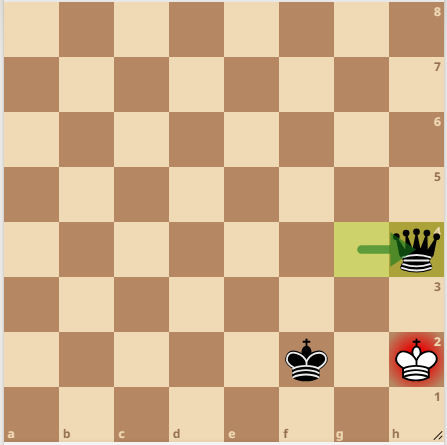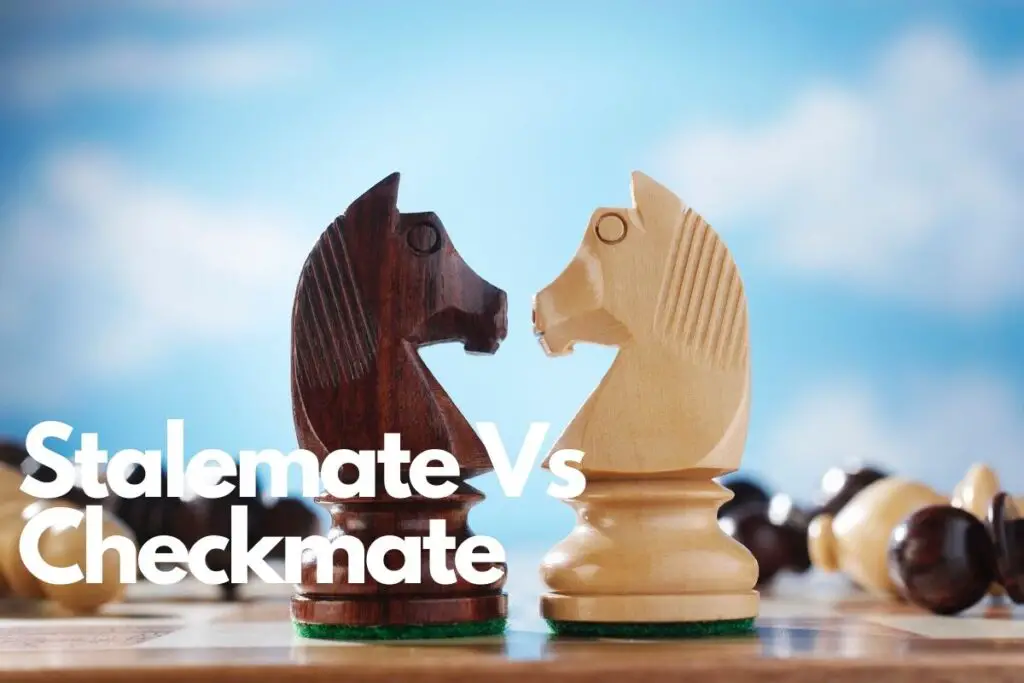Learning chess terminologies can be overwhelming for a beginner. If you’ve been playing chess for quite a while, you may have encountered the terms: stalemate and checkmate. But what exactly are they?
Stalemate is one type of draw that occurs when an opponent has no legal moves to make but his king is NOT under attack. In that case, the game ends with both players rewarded half points. Meanwhile, checkmate occurs when the king is under attack but has no legal moves in the position.
Let’s explore both terms more deeply:
What Is A Stalemate?
In essence, stalemate is one of six draws you can accomplish in chess. It is a situation where the player who is supposed to make a move cannot do so since his King is trapped but NOT in check, and there are no other legal moves to be made.
The game is stalemate with white to move

A game that results in a stalemate would give both players half points, regardless of whether they were winning or losing. That’s why winners often try to keep the game from reaching this point because it’ll cost them half their score if it happens.
How Does It Happen?
Stalemates usually happen at the end of the game when one player has an advantage over their opponent.
This draw can be accidental on the dominating player’s part or a life-saving move the losing player employs to avoid a loss.
As I mentioned, a stalemate occurs when the king has nowhere to go and there are no legal moves to make. This means that any move made with the king would put it in on an endangered square.
A scenario like this can happen when a dominating player lets the idea of winning get to their head and accidentally puts the opposing king into a stalemate position.
Another situation where a stalemate can happen is when both players no longer have enough pieces at the end of the game.
Is It A Bad Thing Or A Good Thing?
Well, it depends if you’re winning or losing. If you’re winning and your opponent gets his king in a stalemate position, you both get half points. This is a bummer since you could’ve earned a solid one point with a checkmate.
If you’re losing, however, being in a stalemate is the most optimal position you can be in. A much better situation than losing and getting zero points—at least you’ll get to go home with half a winner’s points.
What Is A Checkmate?
Checkmate is when a king is in check but has no legal moves to escape or block the attack. Unlike stalemate, where the game ends in a draw, checkmate ends with a clear winner. It came from the Persian word “shah mat,” which means “the king is frozen (helpless).”
Example of checkmate

Unlike stalemate, which is a type of draw, checkmate is the most common of the three ways you can win a chess game.
The other two are resignation by your opponent or a timeout (running out of time), which is usually the case in official tournaments where timers are present.
Difference Between Check And Checkmate
If you’re new to chess, you may wonder what’s the difference between check and checkmate. To keep it simple, both terms mean that the king is threatened. However, being only in ‘check’ shows that your king still has hopes of surviving!
Checkmate, on the other hand, means that:
- The king cannot escape because its surrounding areas are blocked, usually by a friendly piece.
- The available squares the king will move on to would still result in it being checked.
- The player cannot capture/block the piece threatening the king.
How to Avoid A Stalemate
Both stalemate and checkmate are different results of a game where the king cannot move in both situations. The former represents a tie, while the latter constitutes a win or loss.
If you aim to earn more points in a tournament, consider ways to win more games through checkmates and prevent stalemates.
In instances where you’re actually winning, you need to exercise foresight and ensure that your opponent isn’t leading you into their own trap.
The following are four tips you can use to increase your odds of winning a match:
1. Don’t Capture All The Pawns
Keeping some pieces for your opponent to move, like a harmless pawn, will give them the illusion that they still have options for winning the game. It also gives them legal moves, so it wouldn’t be a draw if you accidentally corner their king.
2. Solve Stalemate Puzzles
You can practice solving stalemate puzzles with a friend or mentor. Think of it as training if you’re aiming to play in tournaments.
Exposing yourself to these scenarios can help you prevent accidental draws or falling into an opponent’s attempt at a tie.
3. Keep Checking Your Opponent
Since stalemate requires your opponent to not be in check, then you should keep formulating ways to check your opponent.
If your goal is to prevent a draw, checking your opponent most of the time will, for the most part, put you at an advantage. Remember to think of the big picture, though, and actually checkmate them!
4. Give Your Opponent’s King Some Space
If you can’t check your opponent’s king for any reason, you can try giving the piece some space.
Leaving one or two squares for your opponent’s king to maneuver can help prevent a draw. Once you secure their King’s maneuverability, you can formulate a strategy for a checkmate.
Conclusion
It’s okay to get confused between common chess terms every once in a while. Since stalemates and checkmates both involve the king, some people may mistake the two.
Stalemates are a tie and give both players half points in official tournaments. On the other hand, checkmates are a guaranteed win or lose, which can give you a point or none at all, respectively.
A stalemate is always preferable in a losing game and a checkmate when winning. If you’re winning, you should try to prevent a stalemate from occurring because it’ll cost you half your points.


